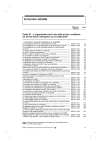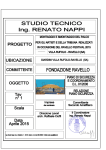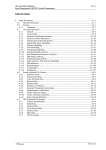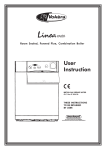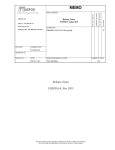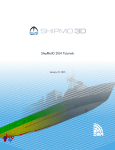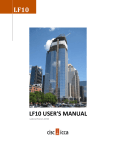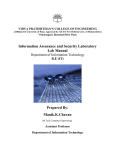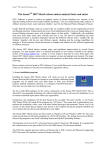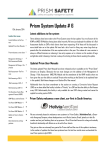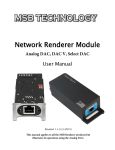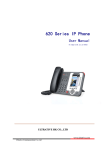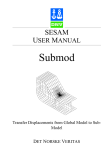Download Sesam GeniE 6.4 Release Note
Transcript
DNV SOFTWARE – A LEADING PROVIDER OF SOFTWARE FOR RELEASE NOTE DOCUMENT Sesam GeniE Version 6.4 RISK 2 | RELEASE NOTE | Sesam GeniE 6.4| WWW.DNVSOFTWARE.COM 9 March 2013 Prepared by DNV Software, an independent business unit of Det Norske Veritas © Det Norske Veritas AS. All rights reserved. This publication or parts thereof may not be reproduced or transmitted in any form or by any means, including copying or recording, without the prior written consent of Det Norske Veritas AS WWW.DNVSOFTWARE.COM Sesam GeniE 6.4 | RELEASE NOTE | 3 TABLE OF CONTENTS 1. INTRODUCTION ............................................................................................................................................... 4 2. HIGHLIGHTS OF THE NEW RELEASE .......................................................................................................... 4 3. HOW TO UPGRADE .......................................................................................................................................... 5 3.1. How to download.......................................................................................................................................... 5 3.2. Upgrading from previous Sesam GeniE versions ......................................................................................... 6 3.3. Other Sesam applications used by Sesam GeniE .......................................................................................... 6 4. DOCUMENTATION........................................................................................................................................... 7 5. MAIN NEWS OF SESAM GENIE 6.4 ............................................................................................................... 7 5.1. Jackets & Topsides ....................................................................................................................................... 7 5.2. Hull and Surface Modelling ........................................................................................................................ 16 5.3. General updates .......................................................................................................................................... 20 5.4. Supporting programs .................................................................................................................................. 22 6. OTHER PRODUCT INFORMATION .............................................................................................................. 24 7. TECHNICAL NOTES ....................................................................................................................................... 25 7.1. Supported operating systems ...................................................................................................................... 25 7.2. Recommended hardware configuration ...................................................................................................... 25 7.3. Supported beam code check standards ....................................................................................................... 27 4 | RELEASE NOTE | Sesam GeniE 6.4| WWW.DNVSOFTWARE.COM 1. INTRODUCTION The release of Sesam GeniE 6.4 is a major release that will enable thousands of users to do more, as well as to do it more easily. The main new features can be summarized as, - full control of the connections between a leg and it’s inner pile tension/compression analysis inside Sesam GeniE alternative equipment mass modelling ignore the breaking wave height limit disconnect beams and plates code checking of piles according to API standard easier and more comprehensive import of model data from Sacs make a surface by simultaneously selecting multiple curves create guiding curves from intersection between shell and plane create guiding curves from the boundaries of a surface export of guiding curves to Rhino format the graphic driver DirectX9 is now the default. Your feedback is important to us and the above improvements are a result of such. We thank you for your continuous support to Sesam. If you have any suggestions, questions or problems please send an email to: [email protected] or contact one of our local offices. “The continuous investments in Sesam lead to new and improved products that help our customers become even more productive and at the same time to achieve a higher degree of quality during import of data from other sources. This release can be characterized as easier and more,” says Ole Jan Nekstad, Product Director Sesam. 2. HIGHLIGHTS OF THE NEW RELEASE The benefits for our valued end-users may be listed as (see also Section 5 for more details): - - - The point connection management used to model the connections between a leg and its inner pile as well as between a conductor and its frame has two clear benefits. The user gets full control of the connection as well as doing all in Sesam GeniE – before this needed to be done in a superelement analysis Tension/compression analysis can now easily be done inside Sesam GeniE – before it was necessary to run the analysis from a utility tool before manually loading the results back to Sesam GeniE The alternative equipment mass modelling is used to ensure a proper load transfer of the mass to avoid false lateral forces in dynamic analysis Users can now decide to ignore the breaking wave height limit check point so that wave load analysis can be carried out typically for shallow waters. Before now this has not been possible The new functionality for disconnecting beams and plates easily models structural components that have common boundaries, but not connected. This has simplified the modelling process as this was only possible using superelement analysis before Code checking of piles according to the API standard has been made easier as two new code checking options have been added without the need to specify buckling lengths of the piles The import of model data from Sacs is now more complete, and includes import of wishbones, piles, soil data, segmented beams and up to 1000 basic load cases WWW.DNVSOFTWARE.COM - Sesam GeniE 6.4 | RELEASE NOTE | 5 The user interface for importing Sacs data models has been made more easy and intuitive as it focuses the most common import options. All other options can be found under the advanced options tab The improved StaadPro data import now includes tension and compression members and it is thus not necessary to manually edit the imported model for such It is now easier to make a surface by simultaneously selecting multiple curves. Before this could only be done by selecting curves individually in one direction before selecting in the other direction Guiding curves can now be made from intersection between shell and plane. Before it was necessary to divide the shell with the plane before making guiding curves from the shell edges Guiding curves from the boundaries of a surface can now be made by a single operation instead of double clicking the surface prior to generating individual guide curves from surface edges The new context sensitive rubber-band select allows the user to be in the same modus to perform either an enclosed-with or touched-by selection. Before it was necessary to shift selection modus each time The data transfer to Rhino is now more complete as Sesam GeniE can export guide curves to Rhino format in addition to importing from Rhino The graphic driver DirectX9 is now the default to support Intel embedded graphic cards or other high performance cards. The OpenGL2 graphic driver is also supported. Before the only option for graphic driver support was OpenGL 3. HOW TO UPGRADE 3.1. HOW TO DOWNLOAD The new version of Sesam GeniE can be downloaded from our Customer Portal located on www.dnvsoftware.com. 6 | RELEASE NOTE | Sesam GeniE 6.4| WWW.DNVSOFTWARE.COM Please notice the following: • • • You need your own user id and password to log in to the Customer Portal. If you don’t have one enter your email address for us to validate you as a user There are two installation kits of Sesam GeniE – one for 32 bit and one for 64 bit operating system The installation kits are self contained and there is therefore no need (like before) to install other Sesam programs or services. If you have a program or service installed from before, the installation program will detect it 3.2. UPGRADING FROM PREVIOUS SESAM GENIE VERSIONS Before you upgrade, please make sure you have relevant data of journal files or xml files to be used when regenerating your models in the new Sesam GeniE version. There are three alternatives for migrating data from a previous version of Sesam GeniE. For a full description about data transfer capabilities and limitations, please consult Section 9.2 in Volume III of the User Manual. You can download the user manual from the Customer Portal before installing the programs. - The first one is by using the journal file – make sure that it runs safely (File|Read Journal File) in the previous Sesam GeniE version before importing to the new version. The journal file is complete and may also contain analysis runs, the code checks and the report generation. - The other alternative is by use of the condensed journal file (the so-called clean js-file). This file is more or less complete for jackets and topsides where there are no curved structures. The environment as well as analysis set-up is also included, but please note that code check data is not part of the clean js-file. - The final option is by use of the XML import and export feature. The XML file contains a neutral definition of the workspace – it is complete except for code check details and reporting. The functionality is available from File|Export XML and File|Import XML. If you are upgrading from Sesam GeniE 6.3, the xml file includes code checking of beams. You can use your existing license file to run the new version of Sesam GeniE. Please note that there are features (typically code checking and modelling of curved structure) that require a license key in addition to the basic program version. 3.3. OTHER SESAM APPLICATIONS USED BY SESAM GENIE The following versions of Sesam applications should be used when running Sesam GeniE 6.4-08: - Wajac 6.3-02 (or later) Splice 6.5-01 (or later) Sestra 8.6-00 (or later), this must be used if you want to do tension-compression analysis Xtract 4.1-02 (or later) DNV Rule Service: 15.20.53, requires a separate installation WWW.DNVSOFTWARE.COM Sesam GeniE 6.4 | RELEASE NOTE | 7 4. DOCUMENTATION The new features are explained in updated user manuals and tutorials. The user manuals update is explained in the release note part of Sesam GeniE 6.4. There are two new tutorials – one concerning tension and compression analysis, the other focusing on import of data models from Sacs. Finally, two more guiding/training documents have been updated. The document Sacs import guidelines helps the user in trouble shooting, while the GeniE Rhino plugin documentation includes export of curves to Rhino format. 5. MAIN NEWS OF SESAM GENIE 6.4 A more detailed description on the main news in this release is given in the following. They are categorized under Jackets & Topsides, Hull and Surface Modelling and General updates. There is also a short description of new features as part of the most recent releases of Sestra, Wajac and Xtract. More details may be found in the status Lists in the Customer Portal, or as part of Sesam GeniE. 5.1. JACKETS & TOPSIDES Point connection management Point connection management will give you full control of connection (proper stiffness and load transfer) typically between a leg and inner pile as well as between a conductor and its frame connection. The same applies to general overlapping beams. The connection can either be specified as fixed, free or with a spring characteristic and is represented as a two-noded beam. When using the spring characteristics the stiffness of grout between leg and inner pile can be included in a linear static analysis also. Before this was only possible using super-element modelling, meaning that you will save modelling time. Furthermore, it will ease the data transfer to non-linear analysis in Usfos as the connections now are part of the data transfer from Sesam GeniE to Usfos. In other words, you do not need to remodel the connections in Usfos unless you want to add non-linear characteristics. 8 | RELEASE NOTE | Sesam GeniE 6.4| WWW.DNVSOFTWARE.COM The feature for point connection management will detect which is the outer beam and which is the inner beam. Hence it is easy to select a connection point and add the relevant connection data as shown below. The point connection management feature is available from the pull-down menu or from the toolbar menu. Its functionality is described in User Manual volume 1. WWW.DNVSOFTWARE.COM Tension-compression (T/C) analysis T/C analysis will help you to compute more precise results where truss elements are either active in tensiononly or compression-only modus. Such analyses are often used in lifting, transportation and jack-up analysis and the special components simulated may typically be wire, cable, absorbers, connectors, slings…. This was not possible to do before without manually deactivating truss members that should not contribute to the stiffness and the force distribution. T/C analysis is easy to perform. First step is to define if the truss member is a tension-only or compression-only. This is done from the browser Properties -> Beam types. Please note that the previous “Truss” element is now called “Tension and Compression”. The second step is to define the analysis to be of type T/C. This is done by either defining a new analysis activity or editing an existing activity. Before the T/C analysis can be done it is necessary to specify which load-cases shall be part of the T/C analysis. This is done by right clicking the analysis activity and edit. To learn more on how to do it, please see User Manual volume 1 or the new tutorial A9. Sesam GeniE 6.4 | RELEASE NOTE | 9 10 | RELEASE NOTE | Sesam GeniE 6.4| Equipment modelling for dynamic/eigenvalue analysis When performing a dynamic or eigenvalue analysis the mass from the equipment is used in the analysis. The equipment mass is “connected” with the structure by using artificial beams. The new feature Vertical Beams and Mass will ensure that only correct forces are imposed to the structure from the connecting artificial beams. As can be seen to the right, the connecting beams now are vertical and are eccentric to the equipment mass. The length of each vertical beam has been set to 1 m. In addition there is a hinge at the bottom of each connecting beam to avoid any moment transfer. Previously, false lateral forces were introduced when using the other mass options. With the new functionality this should not be a problem anymore. To learn more, see the User Manual Volume 3. WWW.DNVSOFTWARE.COM WWW.DNVSOFTWARE.COM Ignoring the breaking wave height limit This functionality will allow the use of wave theories when they are beyond their range of validity. The use of such can give invalid results and the use of these must be based on user judgment. A warning will be given in the output file from the wave load analysis. For shallow waters (typically 15 – 25 meters) the breaking wave height limit is often exceeded. The new functionality will therefore allow such analysis to be performed, whereas before it was stopped. To overrule the breaking wave height limit you open the wave load analysis activity and tick off the option Ignore breaking wave height limit as found under the Special options tab. API 21st wind profile formula The most recent API formula (Extreme API 21st edition) for wind profile is supported in addition to three previous options Extreme API 1st edition, General and Normal. More information may be found in the User Manual volume 2. Sesam GeniE 6.4 | RELEASE NOTE | 11 12 | RELEASE NOTE | Sesam GeniE 6.4| Disconnect beams and plates The new functionality will let you decide where plate edges are connected to beams or adjacent plate edges. The default is still full connection. Since the plate edges are disconnected (they are connected in the corners of the plates) it is possible to also have different mesh settings along the disconnected plate edges. The new feature is available by using the script language. It is easy to do and in the example below there are disconnections between Pl8&Pl20, Pl10&Pl21 and Pl12&Pl22. In addition there are disconnections between Pl17&Bm20 and Pl18&Bm20. The necessary input is as follows: dc=ManualOverlapManager(); dc.Disconnect(Pl8,Pl20); dc.Disconnect(Pl10,Pl21); dc.Disconnect(Pl12,Pl22); dc.Disconnect(Pl17,Bm20); dc.Disconnect(Pl18,Bm20); dc.SetActive(); The pictures to the right show a typical structure (simulating three cracks) and deflections based on the actual pressure loading. Before this required the use of superelement modelling, so such modelling tasks are much easier now. WWW.DNVSOFTWARE.COM WWW.DNVSOFTWARE.COM Code checking of piles to API formula 3.3.1-5 & 6 We have implemented a new functionality for code checking of piles according to API without the need to specify buckling lengths. This will require the use of formula 3.3.1-5 & 6 only. If you want to do an API code check using the traditional “member code check” using the additional formulas you need to specify buckling length. To activate the simplified pile code checking you select “Pile” when creating or editing a code check run. In the example to the right, the code checking of the piles are done using the new functionality. As can be seen the utilization factor is based only on 3.3.1-5 & 6, the maximum Uf is based on the worst of these formulas. It was not possible to do this before; hence pile code checking has been made easier. Sesam GeniE 6.4 | RELEASE NOTE | 13 14 | RELEASE NOTE | Sesam GeniE 6.4| Import model data from Sacs The import of model data from Sacs has been made more complete and easier to do. In addition there is a Sacs import guideline that describes challenges that may occur related to import and how to solve them. This document is found under Sesam GeniE Help “Guiding Documents”. The import capabilities have been extended with import of pile data, soil data, wishbone elements and segmented beams. In addition, the number of imported basic load cases has been increased from 500 to 1000. The increase in capabilities will lead to less manual remodelling when importing the model, and in particular the conversion of wishbone element to 2-noded spring elements (see point connection management) since this data can be automatically re-used when performing a non-linear analysis (e.g. collapse) in Usfos. The pictures to the right show an imported model where wishbone elements were assigned at given locations between leg and its inner pile. Furthermore, the same connection types were used to specify connections between conductors and the conductor frames. Finally, the user interface of the import has been made easier as the advanced import options have been hidden for the regular user – they are available from the tabs Options, Tolerances and Soil as shown on the pictures. The default of each option is also shown. WWW.DNVSOFTWARE.COM WWW.DNVSOFTWARE.COM Import model data from StaadPro The import of section libraries has been made easier because information from the StaadPro section libraries can be displayed if you have local copies of these libraries. This can help you to understand the profiles in question. The converter will attempt to make a best guess for the EUROPEAN, BRITISH and CHINESE sections as displayed. Furthermore, the data conversion identifies tension/compression members and converts them to Sesam GeniE format. The picture to the right shows a model that has been converted and imported into Sesam GeniE. Sesam GeniE 6.4 | RELEASE NOTE | 15 16 | RELEASE NOTE | Sesam GeniE 6.4| 5.2. HULL AND SURFACE MODELLING Faster surface modelling It is now possible to graphically (or from the browser) select several guiding curves to do a curve-net interpolation based on the selection. To do curve-net interpolation before it was necessary to individually select curves one by one, in one or two directions. The new feature will thus help you to be more effective in surface modelling. The new feature is available from the context sensitive menu. The picture to the right shows that 6 curves have been selected by rubber-band select; by selecting the Cover Curve option a curve-net fitting is performed and one single surface is created. Faster creation of guiding curves There are two new options to create guiding curves based on intersections between plates and dividing planes or directly from the plate edges. These options will ease your work to define such guiding curves as compared with before, when more manual steps where needed. The first option is to intersect a surface(s) with a plane and automatically create guiding curve(s) without the need to divide the surface and select each edge to create the curve(s). The functionality is available either from the pull-down menu or from the toolbar menu. WWW.DNVSOFTWARE.COM WWW.DNVSOFTWARE.COM The example to the rights shows that a surface has been selected and that the guiding curves are automatically created by the intersection between the surface and the user-defined plane. The guiding curves may now be used as a reference for typically inserting beams or new surfaces. The other option is to automatically create guiding curves without the need of double clicking the plate, select edges and create guiding curves. This operation is thus much easier with the new functionality. Simply select the surface and create guiding curves by using the functionality from the pull-down menu or from the tool-bar. There are also several other improvements related to making guiding curves and surfaces. For more details see the User Manual volume 1. The picture to the right shows a single surface where guiding curves are automatically inserted. Sesam GeniE 6.4 | RELEASE NOTE | 17 18 | RELEASE NOTE | Sesam GeniE 6.4| Circular fillets A new and more robust algorithm for creating circular arcs between linear segments of splines has been implemented. It replaces the previous algorithm. The old algorithm will still run, but only by defining the commands in the script file. This means that if you import a previous model the same circular fillet as before will be created. The command is available from the pull down menu as well as from the tool bar menu. Select the two incoming curves prior to using the command. A typical circular fillet between two incoming guiding curves is shown to the right. See User Manual volume 1 to learn more. WWW.DNVSOFTWARE.COM WWW.DNVSOFTWARE.COM Import and export of curves Sesam GeniE now supports import of curves (DXF NURBS) from any CAD system. You may also use the Rhino3D plug-in for import and export of curves from Rhino. The new Rhino3D converter can be installed from Sesam GeniE help pages under Guiding Documents. The guiding document has also been updated to include export in addition to import. Sesam GeniE 6.4 | RELEASE NOTE | 19 20 | RELEASE NOTE | Sesam GeniE 6.4| 5.3. GENERAL UPDATES Context sensitive selection of data A new way of rubber-band select has been implemented which will help you to do your selections quicker. It is context sensitive since the direction of the rubber-band expansion will determine “enclosed with” or “touched by” selection. The new selection method is now the default, but you can choose to use the old selection methods as before. It is called “Select Automatic”. The following pictures explain how the new selection method works. WWW.DNVSOFTWARE.COM WWW.DNVSOFTWARE.COM Supporting other graphic devices than OpenGL Several computers come without support for OpenGL. Sesam GeniE now supports DirectX9 (DX9) to ensure proper execution on such computers. DX9 corrects the display errors and instabilities that have been observed during interactive selection e.g. with Intel HD embedded graphics card, where the OpenGL support is poor. DX9 has shown to be the best performing option also for modern High Performance cards, like NVIDIA or ATI. DX9 is from version 6.4 the default graphic system device. If DX9 for some reason causes problem on your computer, you can easily set the graphics device back to OpenGL2 or OpenGL. The Sesam Installer for GeniE will install DX 9 if not already installed on your computer. See also Section 7.2 Recommended hardware configuration of this release note for more information. Sesam GeniE 6.4 | RELEASE NOTE | 21 22 | RELEASE NOTE | Sesam GeniE 6.4| 5.4. SUPPORTING PROGRAMS Sesam GeniE uses other Sesam programs to perform analyses or to do advanced post-processing. Some of these are listed below. At the time of writing of this release note Sestra and Xtract are in the process of being approved for release. For more details about each product, please see the Customer Portal. Sestra version 8.6-00 The installation kit comes with the necessary functionality to do a tension/compression analysis based on Sestra. The user can override error messages related to “bad element shape” and force Sestra to continue to produce results. In such a case the result evaluation must be based on user judgement. • The Sestra listing file will now list all elements with bad element shape – previous versions of Sestra would list one element and then stop Wajac version 6.3-02 Relax wave breaking limits to allow wave load calculations even if the given waves are beyond the breaking limits. The default is still program stop, but the user can override this setting. By doing so Wajac will continue with a warning message printed in the listing file. • • Using wave theories beyond their range of validity can give invalid results The use of results when ignoring breaking wave height limit must be based on user judgement Wind profile formulation according to the 21st version of API can now be used. It is now possible to specify smaller wind mean period ratio (Ta/Ta0). WWW.DNVSOFTWARE.COM WWW.DNVSOFTWARE.COM Xtract version 4.1-02 64-bit version gives “unlimited” memory when viewing results of finite element analysis. • Limitations on model size relaxed and/or removed Performance boost when working with large models having many load cases. Combined dialogue improved with selection of attributes. More intuitive user interface. Sesam GeniE 6.4 | RELEASE NOTE | 23 24 | RELEASE NOTE | Sesam GeniE 6.4| WWW.DNVSOFTWARE.COM 6. OTHER PRODUCT INFORMATION A number of reported program bugs have also been corrected. For more details, please consult the technical release note part of the Sesam GeniE 6.4 installation or from the Status List as found on the Customer Portal. WWW.DNVSOFTWARE.COM Sesam GeniE 6.4 | RELEASE NOTE | 25 7. TECHNICAL NOTES 7.1. SUPPORTED OPERATING SYSTEMS This version of Sesam GeniE has been tested on the following operating systems: • • • Windows XP, 32 and 64 bit operating systems; Service Pack 3 is required for XP 32bit. Windows 7, 32 and 64 bit operating systems Windows 8, 32 and 64 bit operating systems are not supported as the testing on these has been limited as compared to the other operating systems We recommend the use of 64 bit computers. 7.2. RECOMMENDED HARDWARE CONFIGURATION This chapter gives two recommendations on hardware as well as more details on graphic drivers that should be used together with Sesam GeniE. Minimum hardware recommendation This configuration is typical for tasks normally limited to beam jacket and topside design analyses including wave and pile/soil analysis. The configuration is also applicable when making super-elements built up of shell and beams. Furthermore, hydrostatic and hydrodynamic analysis (frequency domain) can also be carried out. • Graphic card: Open GL compatible. May be integrated with PC. If not, use DX9 as provided with the Sesam installation • Memory: 2 GB • Processor: 1.75 GHz • Storage: 100 GB • Display: 17” supporting 1280x1024, alternatively laptop 15” supporting 1280x1024 Preferred hardware recommendation This configuration should be used for all other tasks than mentioned above. • Graphic card: Separate Open GL compatible graphics card (NVIDIA or ATI) with 512MB graphics memory. If not, use DX9 as provided in the Sesam installation • Memory: 4 GB • Processor: 3.0 GHz • Storage: 250 GB • Display: 24” supporting 1900x1200 (or-1080), alternatively laptop 17” supporting 1900x1200 (or-1080) 26 | RELEASE NOTE | Sesam GeniE 6.4| WWW.DNVSOFTWARE.COM Terminology This documentation refers to “graphics drivers” and “GeniE graphics drivers”. The graphics driver is the system level software provided by your Graphics Card supplier (most likely Intel, NVIDIA or ATI) to interface between Windows and the GPU. This is supplied with your operating system or graphics card. The GeniE graphics driver is the software used by GeniE to interface with the graphics driver defined above and is supplied with GeniE. Use of DX9 DirectX 9.0 (DX9) is the preferred GeniE graphics driver and it is the default on installation. DirectX 9.0c Runtime version 9.27.1734 distributed on June 2010 or a later version of DirectX 9 must be installed on your system. The Sesam installer will install DirectX 9.0c. Note that although Windows 7 and 8 come with DirectX pre-installed, GeniE uses extra components and so DirectX must be explicitly installed using the Sesam installer or from the Microsoft website. The GeniE DX9 driver is supported on any DirectX 9.0 compliant graphics hardware (Microsoft Shader Model 3) with the latest vendor-supplied drivers. DirectX 9.0c was first released in August 2004 so older systems will not support the DX9 driver. Use of OpenGL GeniE supports two different OpenGL drivers. The standard GeniE OpenGL driver (“OpenGL”) is a legacy driver that attempts to support all OpenGL 1.1 hardware. The GeniE OpenGL2 driver (“OpenGL2”) is a shader-based driver that is offered as an alternative should a user encounter problems with other drivers. It attempts to support all OpenGL 2.0+ hardware. Driver Fallback/OpenGL on Intel GPUs Each time a workspace is opened GeniE detects if there are any problems reported with the current GeniE driver and if so falls back to another GeniE driver until eventually software rendering is used. The word ‘Fallback’ will be shown in the title bar if this has happened. Due to problems with Intel’s graphics drivers GeniE also attempts to detect if it is being run on an Intel GPU (Graphical Processing Unit) and if so it falls back to the GeniE DX9 driver if possible or to the GeniE OpenGL Software driver. The latter provides no GPU hardware acceleration and so will be slow for large graphical datasets. This test is done each time a workspace is opened so that on hybrid systems where an Intel GPU is paired with NVIDIA or ATI, GeniE will run the driver specified in the GeniE options on NVIDIA or ATI card, but will fall back if a workspace is opened with the Intel GPU active. When to consider upgrading your graphics driver It is strongly advised you upgrade your graphics driver if • you are using an old system (>3 years) and have not upgraded the driver • you have installed Windows 8 on hardware introduced prior to Windows 8 • you encounter graphics problems within GeniE WWW.DNVSOFTWARE.COM Sesam GeniE 6.4 | RELEASE NOTE | 27 Although it is perhaps stating the obvious, if you have no graphics problems using GeniE there is no need to upgrade your graphics driver. It is always possible that a newer version of a driver may have bugs not in your current version. Upgrading the graphics driver is usually best done via the Display Adapter properties dialog in Windows Device Manager. 7.3. SUPPORTED BEAM CODE CHECK STANDARDS Sesam GeniE v6.4 supports the following standards (and their revisions) for beam member code check and punching shear check of tubular joints: • AISC LRFD, 2005 (2010 version also supported, no changes in 2010 which affects the implementation) • AISC ASD, 2005 (2010 version also supported, no changes in 2010 which affects the implementation) • API RP2A LRFD, 2003 (withdrawn by API) • API RP2A WSD, 2002 • API RP2A WSD, 2005 inclusive Errata/Supplement 2007 • Danish Standard DS412, 1983 / DS449, 1983 (member code check only) • Eurocode 3, EN 1993-1-1, 2005/AC:2009 with National Annexes : o Norwegian: NS-EN 1993-1-1:2005/NA:2008/AC:2010 o Danish: EN 1993-1-1 DK NA:2007 • ISO 19902, 1st Edition, 2007 • NORSOK N-004, Rev 2, 2004 You may find more information about supported code check standards from Sesam GeniE Help – either in the user documentation (Volume 4) or from the associated reference documents. 28 | RELEASE NOTE | Sesam GeniE 6.4| WWW.DNVSOFTWARE.COM THIS IS DNV SOFTWARE DNV Software is a leading provider of software for managing risk in the energy, process and maritime industries – offering solutions for design, engineering, strength assessment, risk and reliability, QHSE and asset integrity management. DNV Software is part of DNV and almost 300 DNV offices in 100 countries enable us to be close to our customers and share best practices and quality standards throughout the world. DNV SOFTWARE OFFICES Contact e-mail: [email protected] Support: [email protected] Oslo NO-1322 Høvik Norway Tel: +47 67 57 99 00 Beijing 7/F, East Tower Prosper Centre, Chaoyang District No. 5 Guang Hua Road Beijing 100020 P.R. China Tel: +86 10 6562 7792 Busan 7th Floor, Kolong Bldg, 36-7 Namcheon 1 Dong, Suyong Gu, Busan 613-815 Republic of Korea Tel:+82-51-610-7792 Dubai Bur Juman Office Tower, 14th Floor, Trade Center Road, Dubai, United Arab Emirates Tel: +971 4 352 6626 Ext 308 Gdynia ul. Łużycka 6e, 81537 Gdynia, Poland Tel: +48 58 5115000 Glasgow The Helix Building, 1st Floor, Kelvin Campus, West of Scotland Science Park, Maryhill Road, Glasgow G20 0SP United Kingdom Tel: +44 (0) 141 945 6970 Houston 1400 Ravello Drive, Katy Houston, Texas 77449 USA Tel: +1 281 396 1700 London Palace House 3 Cathedral Street London SE1 9DE United Kingdom Tel: +44 (0)20 7716 6525 Marseille 8 rue Jean-Jacques Vernazza, 1 Marseille France Tel: +33 4 91 13 71 66 Mumbai Emgeen Chambers 10, C.S.T. Road Vidyanagari, Kalina Santacruz (East). Mumbai 400098 India Tel: +91 22 26676667 Paris 69 rue Chevaleret 75013 Paris France Tel: 033 1 44 24 40 10 Rio de Janeiro Rua Sete de Setembro 111/12 Floor 20050006 Rio de Janeiro Brazil Tel: +55 21 3722 7232 Shanghai House No. 36 1591 Hong Qiao Road Shanghai 200336 P.R. China Tel: +86 21 3208 4518 Singapore DNV Technology Centre 10 Science Park Drive Singapore 118224 Singapore Tel: +65 6508 3284 Stavanger Rosenberggata 99 Veritasbygget N-4007 Stavanger Norway Tel: +47 51 50 60 00




























